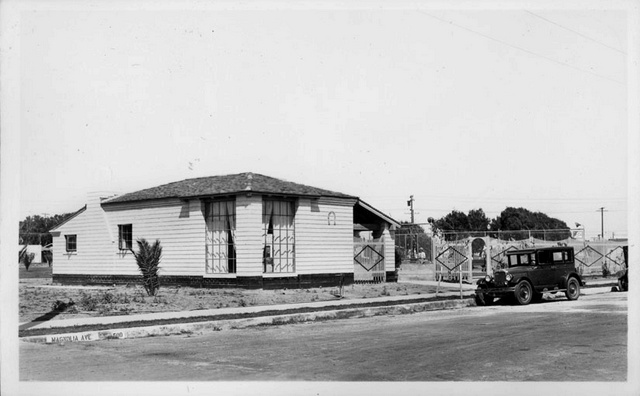"The California bungalow could well be the most beloved house form in Southern California today...bungalows were designed a hundred years ago as active contributors to the character of some of America's greatest neighborhoods."
Old House Journal
A significant part of the quality of life of residential districts in Huntington Beach's historic downtown is the collection of eclectic beach cottages and bungalows on Main Street and the surrounding streets. Try to look at a bungalow or cottage without smiling.
Even our downtown police substation is in a historic bungalow (see #19 The Shank House at http://historichuntingtonbeach.blogspot.com/2012/05/historic-walking-tour-19-shank-house.html). It's worthwhile to take a stroll and explore.
Directions to Walking Tour stop #14: Find the cottage at 415 6th Street, two blocks west of Main Street (this stretch of 6th Street runs parallel to Main Street).
ABOVE: Historic Downtown walking tour stop #14 at 415 6th Street, just up the street from the historic Beach Court (don't forget to say hello to the beach cat that guards Beach Court). This early 20th Century cottage was moved from the oil fields in the 1930s to its present location. (Photo, M. Urashima, Aug. 30 2012) © ALL RIGHTS RESERVED
ABOVE: Sea shells and starfish cover the mailbox of this cottage-style home in the downtown. (Photo, M. Urashima, Aug. 30 2012) © ALL RIGHTS RESERVED
According to Graeme Butler, author of the California Bungalow in Australia (they love them there, too) the term bungalow actually traces its origins to the Indian province of Bengal, derived from the Hindi bangla or house in Bengali style. Bungalows usually have a sloping roof, prominent eaves, dormers, porches, and feature simple craftsman details highlighting natural materials.
ABOVE: Main Street Huntington Beach, a short distance from Triangle Park, Main Street Branch Library, and Art Center. (Photo, M. Urashima, Aug. 30 2012) © ALL RIGHTS RESERVED
Bungalows were a bit of an architectural rebellion against the prior century's excess of Victorian ornamentation and gingerbread. It also was a perfect fit for a Southern California beach town, an ideal climate for open architecture and year-round porches.
ABOVE: California Bungalow Homes: a book on bungalow and cottage building, circa 1911, acknowledged Californians' love for the "new" style. The book details the variety of bungalows and their distinct features. (Image, Environmental Design Archives, University of California Berkeley)
ABOVE: Classic Craftsman style bungalow in Huntington Beach, circa 1935. (Photo, Pomona Public Library)
The difference between a bungalow and a cottage? A bit of a debate on that, as those of us who are architecturally challenged tend to use the terms interchangeably. However, Surf City cottages are simple in style without a wrap-around porch, small in scale, usually featuring wood siding. They often represent Huntington Beach's oldest homes from the late 1800s to early 1900s.
ABOVE: Charming and neat-as-a-pin cottage on Lake Street (formerly known as Railroad Avenue), just a short walk up from the beach where the early 1900s Pacific Electric "red car" brought visitors. This is an example of one of our oldest cottages. (Photo, M. Urashima, Aug. 30 2012) © ALL RIGHTS RESERVED
ABOVE: A classic white picket fence surrounds this adorable cottage on 7th Street. (Photo, M. Urashima, Aug. 30 2012) © ALL RIGHTS RESERVED
ABOVE: A Main Street bungalow with a porch perfect for lemonade and people watching. (Photo, M. Urashima, Aug. 30 2012) © ALL RIGHTS RESERVED
ABOVE: Early 1900s cottages on 6th Street. Note the hand-painted floral mailbox. (Photo, M. Urashima, Aug. 30 2012) © ALL RIGHTS RESERVED
ABOVE: Back on Main Street, a restored 1918 cottage. (Photo, M. Urashima, Aug. 30 2012) © ALL RIGHTS RESERVED
Enchanted with beach cottages and bungalows? We'll periodically post the favorites that can be found walking Historic Huntington Beach's neighborhoods.
All rights reserved. No part of the Historic Huntington Beach blog may be reproduced or duplicated without prior written permission from the author and publisher, M. Adams Urashima.
































